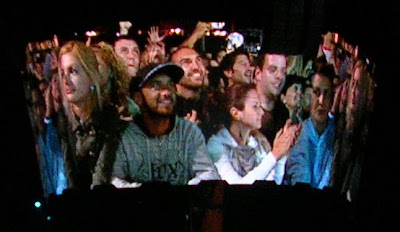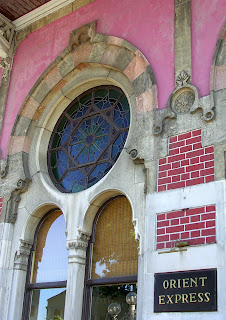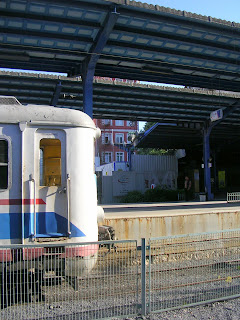Nationalism.
Ethnicity. Religion. Economic status. Politics. If I had to pick a way to save our troubled
world, to guide us beyond these barriers that divide us, the tool I’d start
with to bring us together is music.
Monday night, I was among the 50,000+ people who made the
long journey to an isolated corner of Istanbul,
to a stadium built for Olympic dreams yet unfulfilled. A good friend invited me
along when she realized she had an extra ticket; someone else’s ambivalence led
to my good fortune. As trite as it may seem to attend a concert by an iconic
rock band, experiencing the phenomenon of U2 was a revelation I deeply needed right
now, as Turkey
decides its future this weekend, and Abit and I reevaluate our personal and
professional dreams as well. It’s a new moon, an auspicious time for
beginnings.
On the12
th of September, 30 years to the day of
a
military coup, Turkey will be holding a complicated referendum in which
voters are evenly divided about whether to lessen the power of the military and
increase the prime minister’s authority to appoint the judiciary, among many
other issues too convoluted to elaborate easily. After 12 years of living here,
I’ve got my opinions but no vote, and concern about what will happen after this
Sunday. Even
a
seasoned journalist may not quite get all the nuances of a culture after
years of living and reporting from here, if some spirited commenters are to be
believed. Is Turkish society so deeply divided that the referendum’s issues will
further alienate and stagnate its forward progress?

But this situation is not as baffling as in my birth
country, where the population is psychologically terrorized in these days
leading up to the 9
th anniversary of 9/11 by a mainstream media
obsessed by Koran burning ministers, Obama’s religion and the real motives of a
Sufi
imam in NYC, because the concept that peace-seeking moderate Muslims exist
is impossible to fathom. Turkey’s political issues may be complex, but those in the US are well beyond belief.
This was U2’s first concert in Turkey. They’d stayed away in the
past due to Turkey’s
troubled human rights record. It is symbolic that they relented during our European
Capital of Culture year. Banners on the Galata
Bridge in Turkish and English currently
proclaim that Istanbul
“
builds bridges between cultures.” That’s
a message I’m sure resonated with the group, ambassadors that they are for
fighting poverty, hunger and the
elimination
of AIDS.
Turkey
has cultural bridges to build within the country, as well as in our troubled
neighborhood. Which was why Bono not only called on Washington DC to listen to
the people of Tehran and Palestine, and sent a candlelit message to Burma’s
Aung Sun Suu Kyi that she is not forgotten, but reminded a Turkish audience about
a Kurdish journalist, Fehmi Tosun, who ‘disappeared’ in the southeast in 1995,
a public reminder that may get an average citizen prosecuted.
Bono then brought musical legend and UNESCO Goodwill
Ambassador Zülfü Livaneli on to sing his “
Yiğidim
Aslanım”(My Brave Lion), about a man imprisoned and killed for his
political struggles. Livaneli wrote the haunting soundtrack for Kurdish
actor/director Yilmaz Guney’s classic and controversial film
Yol
(The Road), about the aftermath of that September 1980 coup.
Livaneli said that he and U2 were “song makers”. That’s a
humble description for what these men do. To
stand among tens of thousands of people singing as one, many with tears streaming
down our faces, Bono with his hand over his heart and showing emotion himself, reminded
me of the power of music. A song can link human hearts and let us feel that
strong current of common connection we all share – beyond those barriers of politics,
ethnicity, and religion.

Several songs into their two hour performance, Bono commented that “What is
happening in Turkey now is
important for the country, for Europe and the
world.” That statement was met with cheers and applause. He went on to say
they’d walked across the Bosphorus Bridge the day before with Minister of EU
Affairs Egemen Bağış, a mention greeted with boos by much of the crowd, since
Bağış is part of the ruling party pushing the referendum reforms. A surprised
Bono reacted quickly, saying, “Okay okay! I won’t mention any more politicians,
but can’t I be a tourist and walk across the bridge? It’s a beautiful bridge.
It’s not just from Europe to Asia, not just from the religious to secular, but
from the past to the future, from where Europe has been to where Europe needs to go.”
Where Europe
needs to go. I wonder what leaders in the EU make of that statement? Real
leadership requires visionaries, who sometimes come in the form of rock stars,
while we the people get stuck with power-hungry politicians whose vision stops at
the size of a corporate donation. Bono
meets
with politicians like Erdogan and Sarkozy, attempting to sway their views
with his charismatic charm braced with knowledge. He champions that all-too-rare
belief that with fortune comes the responsibility to give back, setting an
example that democracy requires active involvement from all of us, regardless
of our economic status.
Massive events like this concert are theater, I know. But human beings have
been brought together by drama, by comedy, though performance arts since before
recorded history. Though melodies and languages change, story-telling through
song is in our collective blood. No one is immune. Some showmen are all smoke
and mirrors, little substance. We listen for a good time, to dance and sing, to
forget our daily lives. But Bono and U2 speak to something much deeper than
mere entertainment. Not everyone may like their music, but it’s tough to
disagree with the message: We’re all in this together.
Bono introduced “One” by saying, “We're going to change the name of this song
to 'The Bridge' ". That metaphor is a cliché to those of us who live here, but that
is the role that Turkey
could provide with its unique position in the world. “We are one, but we’re not
the same”, the song goes. It’s truly as simple as that.
One planet, one human family in all its glorious diversity. That we
fixate on those differences and ignore our commonalities is unfortunate human
nature. But sometimes, even for two hours, a crowd of at least 50,000 people from
not only Turkey but all over the world, can be on the same wavelength, can be
reminded that there are many in this world we must help, can realize that
we are in charge of removing those barriers.
Wherever we are, we are ONE. This is why I love U2 – the music is riveting and
danceable, yes – but they have the courage to speak their hearts, and ours.

















































